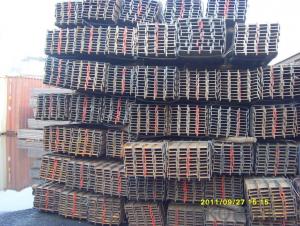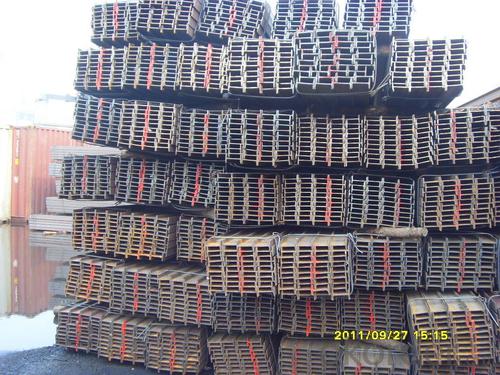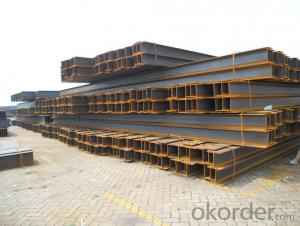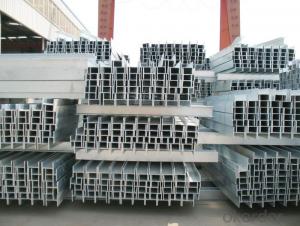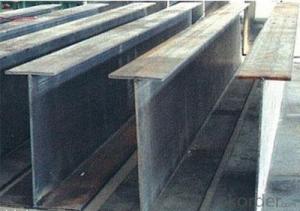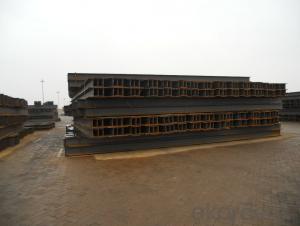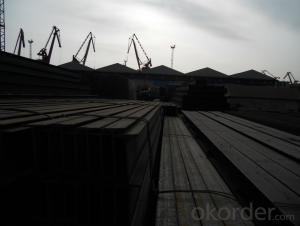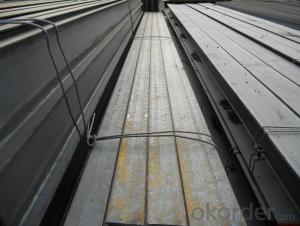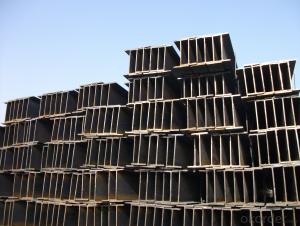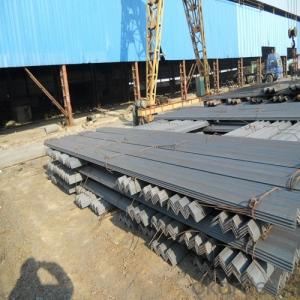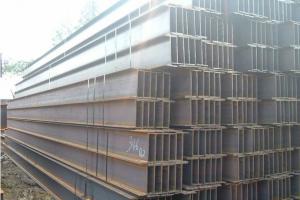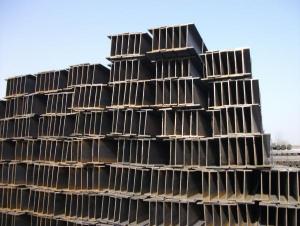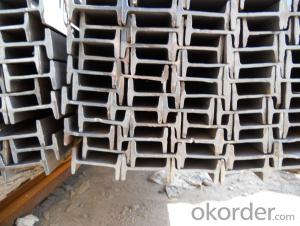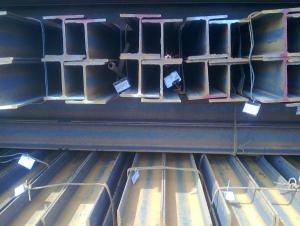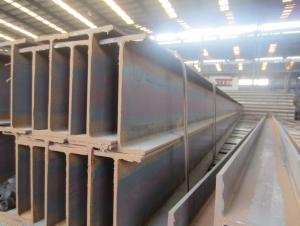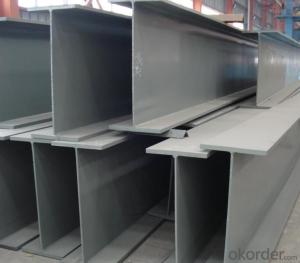Structural Steel H-beam JIS Standard all Size
- Loading Port:
- Tianjin
- Payment Terms:
- TT or LC
- Min Order Qty:
- 25 m.t.
- Supply Capability:
- 2000 m.t./month
OKorder Service Pledge
OKorder Financial Service
You Might Also Like
Product Description:
OKorder is offering Structural Steel H-beam JIS Standard at great prices with worldwide shipping. Our supplier is a world-class manufacturer of steel, with our products utilized the world over. OKorder annually supplies products to European, North American and Asian markets. We provide quotations within 24 hours of receiving an inquiry and guarantee competitive prices.
Product Applications:
Commercial building structure ;Pre-engineered buildings; Machinery support structure; Prefabricated structure; Medium scale bridges; Ship-building structure. etc.
Product Advantages:
OKorder's Structural Steel H-beam JIS Standard are durable, strong, and resist corrosion.
Main Product Features:
· Premium quality
· Prompt delivery & seaworthy packing (30 days after receiving deposit)
· Corrosion resistance
· Can be recycled and reused
· Mill test certification
· Professional Service
· Competitive pricing
Product Description:
OKorder is offering Structural Steel H-beam JIS Standard at great prices with worldwide shipping. Our supplier is a world-class manufacturer of steel, with our products utilized the world over. OKorder annually supplies products to European, North American and Asian markets. We provide quotations within 24 hours of receiving an inquiry and guarantee competitive prices.
Product Applications:
Commercial building structure ;Pre-engineered buildings; Machinery support structure; Prefabricated structure; Medium scale bridges; Ship-building structure. etc.
Product Advantages:
OKorder's Structural Steel H-beam JIS Standard are durable, strong, and resist corrosion.
Main Product Features:
· Premium quality
· Prompt delivery & seaworthy packing (30 days after receiving deposit)
· Corrosion resistance
· Can be recycled and reused
· Mill test certification
· Professional Service
· Competitive pricing
Product Specifications:
Specifications of Hot Rolled Structural Steel H-beam with all Size
1. Standard: GB700-88, Q235B2.
2. Grade: Q235, SS400 or Equivalent
3. Length: 6m,10m, 12m as following table
4. Invoicing on theoretical weight or actual weight as customer request
5.Payment: TT or L/C
Usage & Applications of Hot Rolled Structural Steel H-beam with all Size
Commercial building structure ;Pre-engineered buildings; Machinery support structure; Prefabricated structure; Medium scale bridges; Ship-building structure. etc.
Packaging & Delivery of Hot Rolled Structural Steel H-beam with all Size
1. Packing: it is nude packed in bundles by steel wire rod
2. Bundle weight: not more than 3.5MT for bulk vessel; less than 3 MT for container load
3. Marks:
Color marking: There will be color marking on both end of the bundle for the cargo delivered by bulk vessel. That makes it easily to distinguish at the destination port.
Tag mark: there will be tag mark tied up on the bundles. The information usually including supplier logo and name, product name, made in China, shipping marks and other information request by the customer.
If loading by container the marking is not needed, but we will prepare it as customer request.
4. Transportation: the goods are delivered by truck from mill to loading port, the maximum quantity can be loaded is around 40MTs by each truck. If the order quantity cannot reach the full truck loaded, the transportation cost per ton will be little higher than full load.
5. Delivered by container or bulk vessel
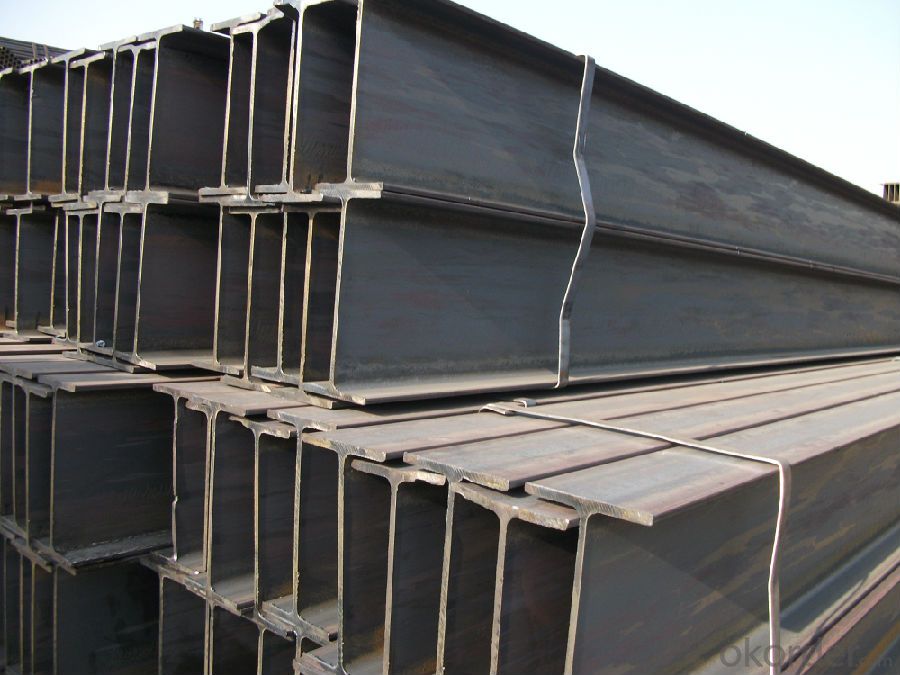
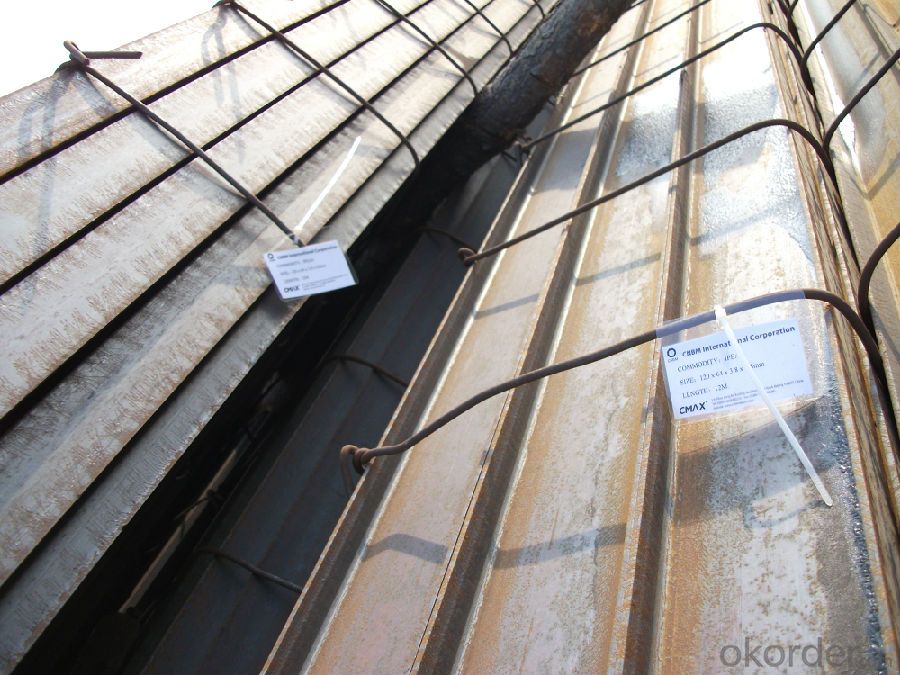
Production flow of Hot Rolled Structural Steel H Beam
Material prepare (billet) —heat up—rough rolling—precision rolling—cooling—packing—storage and transportation
FAQ:
Q1: Why buy Materials & Equipment from OKorder.com?
A1: All products offered byOKorder.com are carefully selected from China's most reliable manufacturing enterprises. Through its ISO certifications, OKorder.com adheres to the highest standards and a commitment to supply chain safety and customer satisfaction.
Q2: How do we guarantee the quality of our products?
A2: We have established an advanced quality management system which conducts strict quality tests at every step, from raw materials to the final product. At the same time, we provide extensive follow-up service assurances as required.
Q3: How soon can we receive the product after purchase?
A3: Within three days of placing an order, we will begin production. The specific shipping date is dependent upon international and government factors, but is typically 7 to 10 workdays.
- Q: Are steel H-beams resistant to seismic forces?
- In general, seismic forces are resisted by steel H-beams. Steel, being a highly durable and strong material, is suitable for withstanding seismic forces caused by earthquakes. H-beams, also referred to as I-beams, provide outstanding structural support due to their shape, which evenly distributes the load along the length of the beam. This shape helps to minimize the impact of seismic forces by effectively dispersing the energy and preventing excessive movement or deformation. Moreover, steel H-beams can be further reinforced using additional materials or techniques, such as cross-bracing or moment resisting frames, to enhance their resistance to seismic activity even more. As a result, construction projects located in earthquake-prone areas commonly utilize steel H-beams, as they offer a high level of resilience against seismic forces.
- Q: How to control the welding deformation made of H steel
- H- steel is a kind of economical section steel with better mechanical performance, especially the cross section, which is named after the English letter "H".
- Q: What are the limitations of steel H-beams?
- There are several limitations to steel H-beams. Firstly, their weight can be a significant drawback, making them difficult to handle and transport. Additionally, steel H-beams may not be suitable for certain applications where lightweight materials are required. Moreover, steel H-beams are prone to corrosion, especially in humid or corrosive environments, which can weaken their structural integrity over time. This necessitates regular maintenance and protective coatings to prevent deterioration. Another limitation is their limited flexibility in terms of design and shape. Steel H-beams are typically available in standard sizes and configurations, which may not always meet specific project requirements. Customization options can be limited and expensive. Finally, steel H-beams can be costlier compared to alternative materials, especially for smaller-scale projects. The high production and transportation costs associated with steel can make it less economical. Overall, while steel H-beams possess numerous advantages, it is crucial to consider these limitations to determine their suitability for a particular construction project.
- Q: Are there any standards or codes that govern the use of steel H-beams?
- Yes, there are several standards and codes that govern the use of steel H-beams. These include industry standards such as the American Society for Testing and Materials (ASTM) standards, the American Institute of Steel Construction (AISC) codes, and the International Building Code (IBC). These standards and codes provide guidelines for the design, fabrication, and installation of steel H-beams to ensure their structural integrity and safety in various applications.
- Q: How do steel H-beams perform in noise reduction applications?
- Noise reduction applications typically do not involve the use of Steel H-beams. Although these beams are commonly utilized in construction and structural projects due to their strength and load-bearing capabilities, they lack a specific design for noise reduction purposes. In terms of reducing noise, there are other materials and techniques that are more effective. For instance, acoustic panels or insulation materials are frequently employed to absorb or block sound waves. These materials possess specific acoustic properties that minimize sound transmission. Conversely, Steel H-beams are primarily employed to provide structural support and stability in buildings and other structures. They are not recognized for their capacity to absorb or block sound. In fact, steel is a dense and rigid material that can actually transmit and amplify sound vibrations rather than reducing them. Hence, if noise reduction is of utmost importance, it is advisable to explore alternative options that are specifically designed for this purpose. Seeking the guidance of acoustic engineers or professionals specializing in noise control can offer more suitable solutions based on the specific requirements and limitations of the project.
- Q: Are steel H-beams suitable for use in the construction of hotels or hospitality buildings?
- Yes, steel H-beams are suitable for use in the construction of hotels or hospitality buildings. Steel H-beams are known for their strength, durability, and load-bearing capabilities, making them ideal for supporting the weight of multi-story structures. Additionally, steel is a versatile material that allows for flexible designs and can withstand various environmental conditions, making it a reliable choice for constructing hotels and hospitality buildings.
- Q: Are steel H-beams suitable for use in the construction of government institutions or buildings?
- Yes, steel H-beams are suitable for use in the construction of government institutions or buildings. Steel H-beams are commonly used in construction projects due to their strength, durability, and versatility. They provide structural support and stability, making them ideal for government institutions or buildings that require large open spaces and high load-bearing capacities. Additionally, steel H-beams can easily be fabricated to meet specific design requirements and can withstand extreme weather conditions. Furthermore, using steel H-beams in construction projects ensures long-term structural integrity and minimizes maintenance costs. Overall, steel H-beams are a reliable and popular choice for government institutions or buildings, providing the necessary strength and stability required for such structures.
- Q: How do steel H-beams perform in high-wind areas?
- Due to their inherent strength and rigidity, steel H-beams are highly effective in high-wind areas. The structural design of H-beams enables them to withstand bending and twisting forces, making them ideal for withstanding the intense loads produced by strong winds. These beams have a considerable load-bearing capacity and can effectively distribute the wind load along their length, which helps prevent structural failure. The wide flanges and thick web of the H-beam shape provide additional stability against wind forces. The flanges function as wings, creating a larger surface area that reduces the wind pressure on the beam. This design feature minimizes the risk of the beam being pushed or bent by the wind. Moreover, steel is a robust and durable material that exhibits exceptional resistance to weathering and corrosion. This quality makes steel H-beams particularly well-suited for high-wind areas, where exposure to harsh weather conditions, such as saltwater or heavy rain, is common. To ensure optimal performance in high-wind areas, it is crucial to consider the specific design requirements and wind loads that a structure may encounter. Engineers employ various methods, such as wind tunnel testing and computational fluid dynamics, to accurately predict the wind forces and select appropriate H-beam sizes and configurations. Additionally, proper installation and anchoring techniques are vital to ensure the H-beams remain securely in place during severe weather events. In conclusion, steel H-beams are specifically designed to excel in high-wind areas. Their structural properties, including strength, rigidity, and resistance to bending, make them highly dependable for withstanding the forces generated by strong winds. When engineered and installed correctly, steel H-beams offer a safe and durable solution for structures in wind-prone regions.
- Q: How do steel H-beams perform in high-temperature applications?
- Steel H-beams perform well in high-temperature applications due to their excellent thermal stability and resistance to deformation. The high melting point and thermal conductivity of steel allow H-beams to withstand elevated temperatures without significant loss in strength or structural integrity. Additionally, steel H-beams have low thermal expansion, which helps to minimize the risk of warping or buckling under extreme heat. Overall, steel H-beams are a reliable choice for high-temperature applications.
- Q: How do Steel H-Beams contribute to the overall occupant productivity of a building?
- Steel H-beams play a crucial role in enhancing the overall occupant productivity of a building in several ways. Firstly, these structural steel beams provide excellent support and stability to the building, ensuring a safe and secure environment for the occupants. This structural integrity creates a sense of comfort and peace of mind, allowing individuals to focus on their work without worrying about the building's stability. Furthermore, steel H-beams have high load-bearing capacity, which enables the construction of larger and more open spaces. This open layout promotes collaboration and communication among occupants, fostering a more productive and efficient work environment. The absence of obstructive columns or walls allows for flexible space planning, making it easier to accommodate different work styles and adapt to changing needs. In addition, steel H-beams have a high strength-to-weight ratio, which means they can withstand heavy loads while being relatively lightweight. This characteristic allows for the construction of taller and more spacious buildings without compromising on safety. The availability of ample natural light and views from higher floors can greatly benefit occupants by improving their overall well-being and productivity. Moreover, steel H-beams are highly durable and resistant to various environmental factors such as fire, earthquakes, and severe weather conditions. This durability ensures the longevity of the building and reduces the need for frequent renovations or repairs, minimizing disruptions to occupants' work routines. Lastly, steel H-beams can be easily fabricated and installed, reducing construction time and costs. This efficiency in construction translates into shorter project timelines, enabling occupants to move into the building sooner and start their operations faster, thus maximizing their productivity. Overall, the utilization of steel H-beams in the construction of buildings greatly contributes to the overall occupant productivity by providing structural stability, creating open and collaborative spaces, optimizing natural light and views, ensuring durability, and enabling faster construction.
Send your message to us
Structural Steel H-beam JIS Standard all Size
- Loading Port:
- Tianjin
- Payment Terms:
- TT or LC
- Min Order Qty:
- 25 m.t.
- Supply Capability:
- 2000 m.t./month
OKorder Service Pledge
OKorder Financial Service
Similar products
Hot products
Hot Searches
Related keywords
